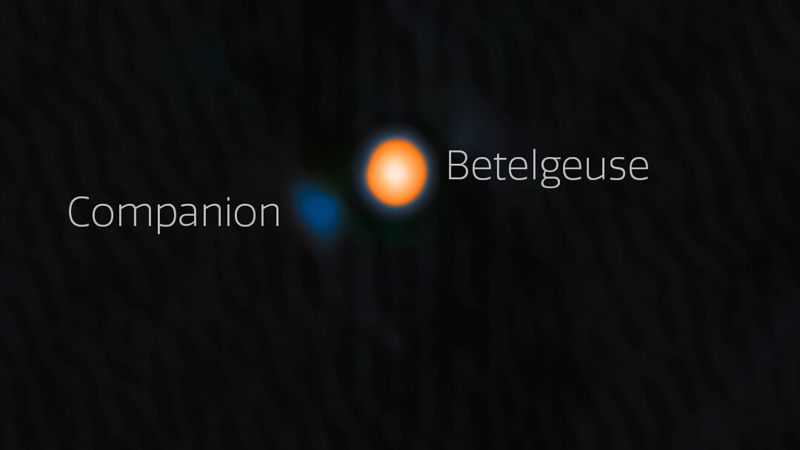Astronomers recently made a groundbreaking discovery that has captivated both the scientific community and casual stargazers alike. They have detected what appears to be a previously unseen companion star orbiting Betelgeuse, the well-known pulsating red supergiant located in the shoulder of the Orion constellation. Betelgeuse is one of the most luminous stars visible in the night sky, drawing the attention of anyone who has looked up to admire its striking reddish glow.
This red giant has long fascinated astronomers due to its variability in brightness, which has intrigued many over the years. Observations have revealed that its brightness fluctuates over time; this raises questions about the underlying mechanisms driving such changes. The newly identified companion star is believed to hold significant insights into why Betelgeuse exhibits these variations.
One pivotal event that sparked intense interest in Betelgeuse was the phenomenon known as the “Great Dimming,” which occurred from late 2019 to early 2020. During this period, the star dimmed dramatically, leading astronomers to speculate that it was nearing the end of its life cycle and might explode as a supernova. Subsequent investigations revealed that a massive dust cloud had been ejected by the star, temporarily obscuring its light from Earth. This event opened up a new chapter in understanding Betelgeuse’s behavior, leading researchers to delve deeper into its properties and cycle of brightness fluctuations, previously noted to occur roughly every six years.
By employing advanced imaging techniques using the Gemini North telescope in Hawaii, a team of astronomers led by Steve Howell identified the companion star, dubbed “Betelbuddy.” They proposed the name “Siwarha,” meaning “her bracelet” in Arabic, which aligns beautifully with Betelgeuse’s own Arabic name, translating to “Hand of the Giant.” This discovery is not just an academic exercise; understanding the relationship between Betelgeuse and its companion could offer insights into their fates.
Betelgeuse is astonishingly massive, with approximately 700 times the radius of our Sun and 18 times its mass. To put that into perspective, if the Sun were replaced with Betelgeuse, it would consume Earth and reach past the orbit of Jupiter, shining 7,500 to 14,000 times brighter than the Sun. Despite being only 10 million years old—a mere fraction of the Sun’s estimated 4.5 billion years—Betelgeuse has already exhausted the hydrogen at its core, causing it to expand as it nears the end of its stellar life.
Observations have recorded that Betelgeuse’s luminosity oscillates in a cycle of about 416 days. However, scientists noted a longer variability of approximately 2,170 days, or six years, which remained shrouded in mystery for decades. Independent research teams used the Hubble Space Telescope and NASA’s Chandra X-Ray Observatory in 2024 but were unable to confirm the existence of the companion star due to the overwhelming brightness of Betelgeuse.
To tackle this challenge, Howell’s team utilized a unique technique known as speckle imaging, which captures thousands of brief exposures, effectively eliminating atmospheric distortions and allowing for a clearer view of celestial objects. During their observations, they detected a faint blue glow indicating the companion star, confirming earlier predictions made by other researchers.
The companion star is relatively young, exhibiting a mass about 1.5 times that of the Sun and has not yet begun hydrogen fusion. This faintness was a significant reason for its earlier invisibility, with its light just four-tenths of one percent as bright as Betelgeuse. Their close proximity complicated the task of discerning the two stars, but the different hues of Betelgeuse and its companion aided in their detection.
The study represents the first observation of a stellar companion orbiting so closely to a supergiant star. Howell expressed surprise at how apparent the companion was after data processing, expecting the search to be more arduous. This observation aligns with research trends noting that Betelgeuse exhibits a wobbly motion toward and away from Earth in the same six-year cycle due to this companion.
While Howell and his colleagues made this pioneering detection, future observations are essential for confirming it fully. Experts caution that given the measurement limits, relying solely on this initial observation may not be conclusive. Confirming the companion’s presence in its expected six-year orbital cycle will solidify this finding, and astronomers will get their next chance to observe it in November 2027 when it will be farthest from Betelgeuse.
Yet, amidst this excitement lies the unsettling anticipation of when Betelgeuse might explode. As they unravel the mysteries of this duo, researchers ponder the implications of the companion star’s close orbit in the inner layers of Betelgeuse’s atmosphere, where it could eventually meet its demise. Whether the companion will drift into Betelgeuse’s embrace in about 10,












